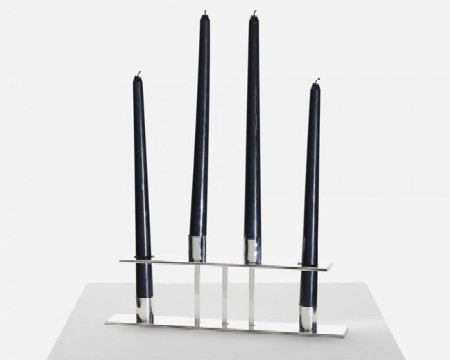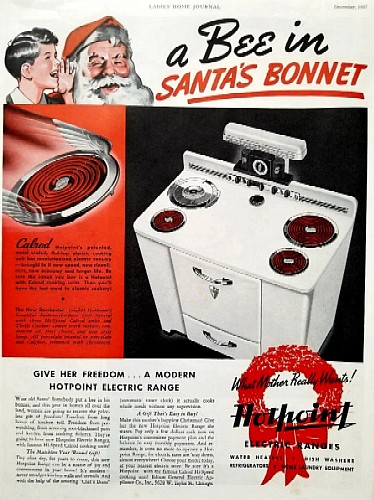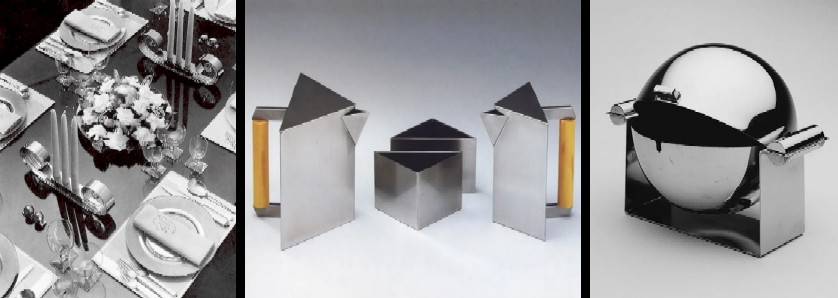
Helen Hughes Delaney (1885-1968)
"It isn't often that an untrained inland artist acquires national recognition, as Helen Hughes Dulany has done, in a little more than three years. It is epochal when that artist progresses in that interim not only

Helen Hughes Dulaney with her Zephyr Stainless Steel Table Settings, From the
December 16,
1934, Chicago Sunday Tribune, Section 7, Page 7
from obscurity to fame but from the status of a hopeless invalid to the brisk, brimming days of an overworked genius with a many-angled career. And loves it." (Kathleen McLaughlin, "A Woman's Rise to Fame as Designer", Chicago Sunday Tribune, December 15, 1934, Part 7, Page 7)
Although she had a short, 7 year career as a designer, Helen Hughes-Dulany's story is as interesting as the items she created. She became well known in the mid-1930s for her original, modernist designs, patenting processes and products and using the relatively new stainless steel in ways which experts said it couldn't be used. She was the model of a bootstrapping business leader, creating a woman-owned business almost entirely on her own according to McLaughlin.
Helen Hughes was born to a wealthy family in North Dakota. She became a socialite, marrying wealthy Iowa lumber baron George W. Dulany in May of 1913. They moved to Chicago in 1920. She discovered a talent for art when she began working with modeling clay while an invalid in 1931. She had been "warned by physicians that she probably never would return to an active life. ...She attempted portraiture and turned out almost uncanny likenesses. Gradually and unexpectedly she regained her health." (McLaughlin)
Hughes-Dulany discovered an interest in creating interior furnishings after she moved into an

Helen Hughes Dulaney Hotpoint Stove Design, Ad in Ladie's
Home Journal, Dec. 1937
apartment following recovery from her illness. She found that "none of the family heirlooms would fit gracefully. ...Under the impression... that she hated the furniture called 'modern', she began to design her own." Needing help realizing her designs, she searched for men to manufacture them. When she approached them, these men "often laughed at her, then listened, then grew interested, then set their hands and minds to the task and solved it." (McLaughlin) "People were amazed at the look of the apartment and 'her designs were featured in magazines such as House Beautiful, Better Homes and Gardens, Creative Design, and Arts and Decoration.'" (Curtis Erismoen, "The 'foremost woman industrial stylist' during the 1930s was born and raised in North Dakota", Inforum, gathered April 22, 2024)
Once she saw how well her designs worked, she decided to produce them under the company HHD (her initials) Studio. Unfortunately, the Dulany family fortune had taken a hit during the depression. "But she had fifty dollars of her own that 'wasn't working', so she risked it to finance her venture. With a number of articles of her own design... she went to New York and came back with a pocketful of orders. She is exultantly proud of the fact that she has never borrowed a nickel from her family or friends for the enterprise." (McLaughlin)
As her designs gained favor, New York started sending buyers to Chicago

Helen Hughes Dulaney Hotpoint Stove Design, Ad in Ladie's
Home Journal, Dec. 1937
to see her and to place orders.
"Another outstanding institution in San Francisco phoned her fretfully recently that it couldn't find her work on exhibit in the east, and would it have to send a buyer to her from the west coast?
'Fraid so, if you want it,' was the reply. 'I'm showing only in Chicago.'
'In New York I am only one of dozens,' she explains. 'In Chicago the field is less crowded and I am an individual.'" (McLaughlin)
Upon hearing about her, General Electric contracted her studio to redesign their popular Hotpont stoves. (See the image of the advertisement attached for more on this.) Hughes-Dulany experimented with a variety of materials, including chromium, brass, wood, glass, copper and stainless steel. "It was Mrs. Dulany who first 'fashioned' stainless steel into service plates, coffee services - made by hand - and other bric-a-brac, when the steel men themselves told her it 'couldn't be done.' It was she who discovered a method for backing glass [with metal]... to prevent the edges from chipping, when old and expert hands at the game long since had give up the problem." She filed a variety of patents for products created by her company including salt and pepper shakers and a cocktail glass/shaker.
Helen filed for divorce from George in December of 1936, charging him with desertion in November of 1935, resulting in a settlement. (https://www.newspapers.com/.../the-indianapolis.../5838788/) "Dulany all but disappeared from design, apparently as an unfortunate consequence of her divorce". (Indianapolis Star, December 7, 1936. p. 7) In fact, she closed her Chicago studio in 1937 and moved to Honolulu, Hawaii where she had vacationed the year before to escape from the pressures of her work. In Jan. 22, 1938, she married Atherton Richards, the president/manager of Hawaiian Pineapple Company with whom she had worked to create a new packaging design in 1936. Before the US entered World War II, Hawaii was said to be a potential target of the Japanese, so Helen decided to move to New York City. There she was hired by Readers Digest to be a "roving editor." She divorced Richards in 1955, on the grounds of "grievous mental suffering."
Sources Not Mentioned:
"Why does the world need to know about Helen Hughes Delaney?", Rethinking the Future Website, gathered April 22, 2024
Video, Industrial Designer Helen Hughes Delaney, All Arts
Original Facebook Group Profile
 Some Dulaney Productions, from left - Table Setting, House and Gardem, 1934, Fine Art America; , Coffee Service Set Including Coffee Pot, NESCAFE pot (according to one source) and two cups, Stainless Steel, Bakelite Handles, 1934, New York MET; Caviar Server, Chromed Metal, HD Studio , 1930s, Brooklyn Museum
Some Dulaney Productions, from left - Table Setting, House and Gardem, 1934, Fine Art America; , Coffee Service Set Including Coffee Pot, NESCAFE pot (according to one source) and two cups, Stainless Steel, Bakelite Handles, 1934, New York MET; Caviar Server, Chromed Metal, HD Studio , 1930s, Brooklyn Museum